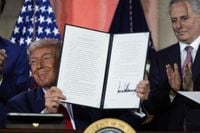On October 1, 2025, as the clock struck midnight and the federal government officially entered a shutdown, President Donald Trump stood in the Oval Office to sign a sweeping executive order. The order pledged millions of dollars to a new frontier in pediatric cancer research: artificial intelligence. This move, coming amid a swirl of controversy over massive cuts to traditional medical research funding, has ignited debate across the scientific, political, and patient communities.
According to CNN, Trump’s executive order directs an immediate $50 million surge in funding to the National Institutes of Health’s (NIH) Childhood Cancer Data Initiative, effectively doubling its budget. The initiative, originally launched during Trump’s first term, is now being reimagined to harness the potential of AI in the fight against childhood cancer. The White House has made clear that part of this investment is earmarked specifically for researchers exploring how AI can be applied to pediatric cancer research.
“AI can be used to build upon this data initiative to produce meaningful solutions to pediatric, adolescent, and young adulthood cancer,” the executive order reads, as quoted by Deseret News. “This application of AI has the potential to transform the Nation’s current care and research approach for pediatric cancer.”
The order directs the Make America Healthy Again Commission to collaborate with Health and Human Services Secretary Robert F. Kennedy Jr. and leading figures in artificial intelligence. Their mission: to develop new ways AI can improve diagnoses, treatments, cures, and prevention strategies for childhood cancer. The order highlights the pressing need for innovation, noting that children and families have long battled cancer and its chronic effects while relying on outdated technology. “We must prioritize investment in AI-enabled science, build world-class scientific datasets, and empower researchers and clinicians with the tools needed to translate data and AI capabilities into improved care,” the order continues.
Trump, in remarks from the Oval Office, expressed his enthusiasm for the initiative. “I am thrilled to sign this order to accelerate research and use the extraordinary potential of artificial intelligence to fight this terrible disease,” he said, according to Deseret News. At a White House briefing, he doubled down on the promise of AI: “Using cutting-edge AI, we will empower scientists and researchers to discover new treatments, cures and prevention strategies. AI can also make groundbreaking trials and therapies. It's just going to be so accessible to everybody—families all over the country. It’s going to be amazing.”
The World Health Organization estimates that around 400,000 children under 19 years old are diagnosed with cancer worldwide each year—a staggering figure that underscores the urgency of improving research and treatment. NCI Director Anthony Letai, M.D., Ph.D., who was newly appointed to the role, echoed this sense of mission. “We will not stop until childhood cancer is a thing of the past,” Letai stated in a release, adding, “I cannot think of a better way to begin my tenure at NCI than to redouble our efforts to support our youngest patients and their families facing rare leukemias and other cancers.”
But as the administration touts the promise of AI, critics are raising alarms over the broader context. The new $50 million investment—called a “funding surge” by the White House—is dwarfed by the billions in cuts proposed and enacted elsewhere. According to STAT News, Trump’s administration has proposed slashing $18 billion from the NIH’s budget for the 2026 fiscal year, with the Senate currently resisting his push for a 40% reduction. Since the start of Trump’s second term, over 3,500 research grants have been terminated, and the NIH has lost an estimated $12 billion in research funding. The National Cancer Institute, which houses the Childhood Cancer Data Initiative, faces a proposed 37% budget cut, and hundreds of millions of dollars in research grants have already been withheld.
These cuts have had real consequences. Earlier this year, the NCI announced the end of its support for a 26-year-old clinical trials consortium focused on pediatric brain tumors. Researchers working on treatments for aggressive childhood cancers, like medulloblastoma, have seen their projects defunded. The administration has justified these actions by citing executive orders that prohibit funding for science deemed out of alignment with its policies—orders that, among other things, eliminate diversity initiatives and restrict the recognition of gender diversity in federally funded research.
Critics, including many in the scientific community, see the AI initiative as a shiny distraction from the gutting of traditional biomedical research. As reported by Gizmodo, “We used to have actual pediatric cancer research! Lots of it! But then the administration made life hell for science professionals at the National Cancer Institute and demanded it slash spending by more than one-third.” The article notes that the new AI-driven approach is being led by the Office of Science and Technology Policy (OSTP), directed by Michael Kratsios—a figure whose background is in Silicon Valley venture capital, not biomedical research.
Kratsios, for his part, has described the project in glowing terms: “Leveraging this data infrastructure, researchers will deploy artificial intelligence to improve clinical trials, sharpen diagnoses, fine tune treatments, unlock cures and strengthen prevention strategies.” Yet, as critics point out, there are few concrete details about how the AI-driven research will operate or how contracts will be awarded. The lack of transparency has fueled skepticism that the program may serve more as a boon for tech companies than for patients.
Meanwhile, the federal government’s shutdown has only compounded the turmoil. As reported by ABC News, the shutdown began at 12:01 a.m. on October 1, 2025, after a political deadlock over congressional spending bills. President Trump and Republicans have blamed Democrats’ health care demands, while Democrats insist that Republicans need to negotiate. The administration has threatened mass layoffs of federal workers during the shutdown, and the Department of Health and Human Services has already lost about 20,000 employees since January. Over 150,000 federal workers have reportedly resigned amid the shutdown and related buyout programs, marking the largest mass resignation in nearly a century.
Despite the fanfare around the AI initiative, many in the research and patient advocacy communities remain wary. They argue that while AI holds promise, it cannot replace the foundational work of traditional scientific research—work that has been severely undermined by funding cuts and workforce reductions. The inclusion of unnamed private-sector partners in the initiative has also raised eyebrows, with some critics suggesting that the program could become a windfall for technology companies with political connections.
Still, the White House insists that the United States will remain a leader in biomedical innovation. “The President is committed to making the United States the world leader in biomedicine in the 21st Century, just as it was in the 20th Century, and the idea that the President isn't committed to cutting cancer is just incorrect,” a White House official told Gizmodo.
As the debate rages on, one thing is clear: the future of pediatric cancer research in America is at a crossroads. Whether the pivot to AI will deliver on its promise—or simply mask the damage done by unprecedented funding cuts—remains to be seen. For the families of the 400,000 children diagnosed with cancer each year, the stakes could not be higher.


